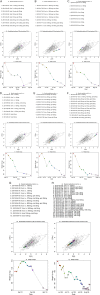Body composition analysis in patients with acute heart failure: the Scale Heart Failure trial
- PMID: 34647695
- PMCID: PMC8712800
- DOI: 10.1002/ehf2.13641
Body composition analysis in patients with acute heart failure: the Scale Heart Failure trial
Abstract
Aims: In this study, we aimed to investigate whether body composition analysis (BCA) derived from bioelectrical impedance vector analysis (BIVA) could be used to monitor the hydration status of patients with acute heart failure (AHF) during intensified diuretic therapy.
Methods and results: This observational, single-centre study involved a novel, validated eight-electrode segmental body composition analyser to perform BCA derived from BIVA with an alternating current of 100 μA at frequencies of 5, 7.5, 50, and 75 kHz. The BCA-derived and BIVA-derived parameters were estimated and compared with daily body weight measurements in hospitalized patients with AHF. A total of 867 BCA and BIVA assessments were conducted in 142 patients (56.3% men; age 76.8 ± 10.7 years). Daily changes in total body water (TBW) and extracellular water (ECW) were significantly associated with changes in body weight in 62.2% and 89.1% of all measurements, respectively (range, ±1 kg). Repeated measures correlation coefficients between weight loss and TBW loss resulted with rho 0.43, P < 0.01, confidence interval (CI) [0.36, 0.50] and rho 0.71, P > 0.01, CI [0.67, 0.75] for ECW loss. Between the first and last assessments, the mean weight loss was -2.5 kg, compared with the -2.6 L mean TBW loss and -1.7 L mean ECW loss. BIVA revealed an increase in mean Resistance R and mean Reactance Xc across all frequencies, with the subsequent reduction in body fluid (including corresponding body weight) between the first and last assessments.
Conclusions: Body composition analysis derived from BIVA with a focus on ECW is a promising approach to detect changes in hydration status in patients undergoing intensified diuretic therapy. Defining personalized BIVA reference values using bioelectrical impedance devices is a promising approach to monitor hydration status.
Keywords: Acute heart failure; Bioelectrical impedance vector analysis; Body composition analysis; Diuretic therapy; Impedance; eHealth.
© 2021 The Authors. ESC Heart Failure published by John Wiley & Sons Ltd on behalf of European Society of Cardiology.
Conflict of interest statement
No conflicts of interest to declare.
Figures




References
-
- Ambrosy AP, Fonarow GC, Butler J, Chioncel O, Greene SJ, Vaduganathan M, Nodari S, Lam CSP, Sato N, Shah AN, Gheorghiade M. The global health and economic burden of hospitalizations for heart failure. Lessons learned from hospitalized heart failure registries. J Am Coll Cardiol 2014; 63: 1123–1133. - PubMed
-
- Cook C, Cole G, Asaria P, Jabbour R, Francis DP. The annual global economic burden of heart failure. Int J Cardiol 2014. 2014/02/15/; 171: 368–376. - PubMed
-
- Pocock SJ, Ariti CA, McMurray JJV, Maggioni A, Køber L, Squire IB, Swedberg K, Dobson J, Poppe KK, Whalley GA, Doughty RN, on behalf of the Meta‐Analysis Global Group in Chronic Heart Failure (MAGGIC) . Predicting survival in heart failure: a risk score based on 39 372 patients from 30 studies. Eur Heart J 2013; 34: 1404–1413. - PubMed
-
- Fonarow GC, Stough WG, Abraham WT, Albert NM, Gheorghiade M, Greenberg BH, O'Connor CM, Sun JL, Yancy CW, Young JB. Characteristics, treatments, and outcomes of patients with preserved systolic function hospitalized for heart failure: a report from the OPTIMIZE‐HF registry. J Am Coll Cardiol 2007. 2007/08/21/; 50: 768–777. - PubMed
-
- Coats AJS, Pieske B, Linde C, Jankowska EA, Ruschitzka F, Rutten FH, Rosano GMC, Bueno H, Riley JP, Cleland JGF, Parissis JT, González‐Juanatey JR, Ruilope LM, Jessup M, van der Meer P, Nihoyannopoulos P, Anker SD, Harjola V‐P, Falk V, Voors AA, Ponikowski P, Group ESD . 2016 ESC Guidelines for the diagnosis and treatment of acute and chronic heart failure: the Task Force for the diagnosis and treatment of acute and chronic heart failure of the European Society of Cardiology (ESC) Developed with the special contribution of the Heart Failure Association (HFA) of the ESC. Eur Heart J 2016; 37: 2129–2200. - PubMed
Publication types
MeSH terms
LinkOut - more resources
Full Text Sources
Medical

